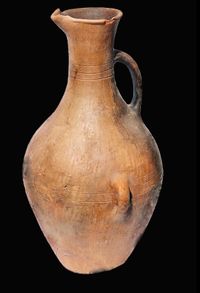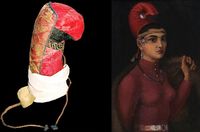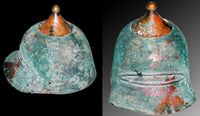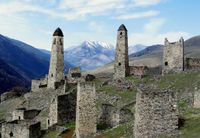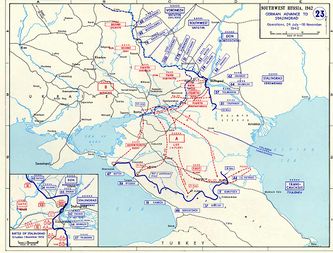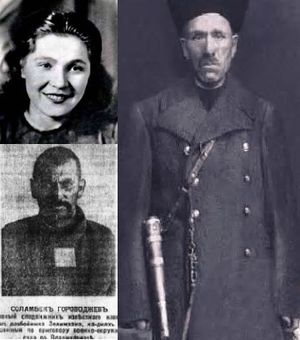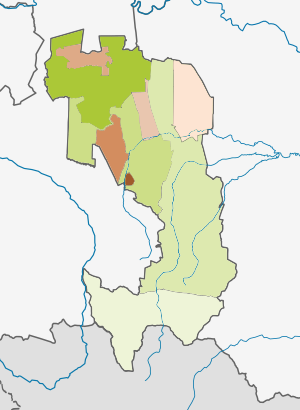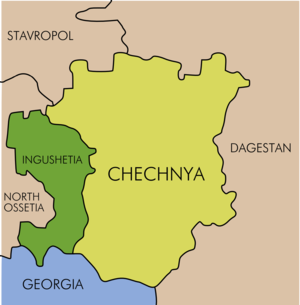إنگوشتيا
Republic of Ingushetia | |
|---|---|
| Республика Ингушетия | |
| الترجمة اللفظية بالـ Other | |
| • الإنگوشية | ГӀалгӀай Мохк |
| النشيد: النشيد القومي لجمهورية إنگوشتيا | |
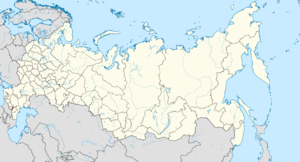 | |
| البلد | روسيا |
| المنطقة الاتحادية | شمال القوقاز[1] |
| المنطقة الاقتصادية | شمال القوقاز[2] |
| تأسست | 4 يونيو 1992 |
| العاصمة | ماگاس |
| الحكومة | |
| • الكيان | People's Assembly[3] |
| • الرئيس[3] | يونس-بك يڤكوروڤ[4] |
| المساحة | |
| • Total | 3٬500 كم² (1٬400 ميل²) |
| ترتيب المساحة | 81st |
| التعداد (2010 Census)[6] | |
| • Total | 412٬997 |
| • Estimate (2018) | 488٬043 (+18٫2%) |
| • الترتيب | 75th |
| • الكثافة | 120/km2 (310/sq mi) |
| • Urban | 38٫3% |
| • الريف | 61٫7% |
| منطقة التوقيت | UTC+3 (توقيت موسكو |
| ISO 3166 code | RU-IN |
| لوحات السيارات | 06 |
| OKTMO ID | 26000000 |
| اللغات الرسمية | الروسية;[8] الإنگوشية[9] |
| الموقع الإلكتروني | http://www.ingushetia.ru/ |
جمهورية إنگوشتيا (بالإنگوشية: ГIалгIай Мохк ، وتُنطق Ğalğaj Moxk؛ وبالروسية: Респу́блика Ингуше́тия) هي كيان فدرالي في روسيا الإتحادية (جمهورية).
Its capital is the town of Magas. At 3,000 square km, in terms of area, the republic is the smallest of Russia's federal subjects except for the federal cities. It was established on June 4, 1992, after the Chechen-Ingush Autonomous Soviet Socialist Republic was split in two.[10][11] The republic is home to the indigenous Ingush, a people of Vainakh ancestry. As of the 2010 Census, its population was 412,529.[12]
Largely due to the insurgency in the North Caucasus, Ingushetia remains one of the poorest and most unstable regions of Russia. Although the violence has died down in recent years,[13][14] the insurgency in neighboring Chechnya has occasionally spilled into Ingushetia. According to Human Rights Watch in 2008, the republic has been destabilized by corruption, a number of high-profile crimes (including kidnapping and murder of civilians by government security forces[15]), anti-government protests, attacks on soldiers and officers, Russian military excesses and a deteriorating human rights situation.[16][17]
أصل الاسم
The name Ingushetia is derived from the ancient village Angusht, which was renamed into Tarskoye and transferred to North Ossetia in 1944 after the deportation of 23 February 1944, a.k.a. operation "Lentil".
The Ingush, a nationality group indigenous to the Caucasus, mostly inhabit Ingushetia. They refer to themselves as Ghalghai (from Ingush: Ghala ("fortress" or "town") and ghai ("inhabitants" or "citizens"). The Ingush speak the Ingush language, which has a very high degree of mutual intelligibility with neighboring Chechen. The Ingush are traditionally a classless society based on a clan system and unwritten law (approximately 350 clans live in Ingushetia today). Every clan, and each clan member, are viewed as equal. Unlike the neighboring nations in the Caucasus (including Chechens), the Ingush never had social superiors or inferiors. The Ingush/Ingushetia were also known by the following names: Gelia (American cartographer J. H. Colton), Tschetschna (German geographers Joseph Grassl and Joseph Meyer), Ghalghai/Gelgai (Self), Nakh (self, meaning "people"), Vainakh (self, meaning "our people"), Kist (Georgian), Gergar (Self), Dzurdzuk (Georgian), Ghlighvi (Georgian), Angushtini (Russian), Mack-aloni (Ossetian), Orstkhoi (self), Nart-Orstkhoi (self), Galash (self), Tsori (self), Dzheirakhoi (self), Khamhoi (self), Metshal (self), Fyappi (self), and Nyasareth (self). The self-namings represent different Vainakh tribes which make up the Ingush population today.[18] The history of the Ingush is closely related to Chechens. Byzantine and Georgian missionaries partially Christianised the Ingush, although Christianity was weakened by the Mongol invasions. The remains of several churches, notably the Tkhabya-Yerd and the Albe-Yerd can be found in Ingushetia. Ingush converted to Islam at the end of the 19th century, which is almost three centuries after the beginning of Islamization in Chechnya.
أصل سكان إنگوشتيا
According to Leonti Mroveli, the 11th-century Georgian chronicler, the word Caucasian is derived from the Vainakh ancestor Kavkas.[19] According to Professor George Anchabadze of Ilia State University "The Vainakhs are the ancient natives of the Caucasus. It is noteworthy, that according to the genealogical table drawn up by Leonti Mroveli, the legendary forefather of the Vainakhs was "Kavkas", hence the name Kavkasians, one of the ethnicons met in the ancient Georgian written sources, signifying the ancestors of the Chechens and Ingush. As appears from the above, the Vainakhs, at least by name, are presented as the most "Caucasian" people of all the Caucasians (Caucasus – Kavkas – Kavkasians) in the Georgian historical tradition."[20][21] The Soviet-Russian anthropologists and scientists N.Ya. Marr, V.V. Bounak, R.M. Munchaev, I.M Dyakonov, E.I. Krupnov and G.A. Melikashvilli wrote: "Among Ingush the Caucasian type is preserved better than among any other North Caucasian nation", Professor of anthropology V.V.Bounak "Groznenski Rabochi" 5, VII, 1935. Professor G.F.Debets recognized that Ingush Caucasian anthropologic type is the most Caucasian among Caucasians.[22] In an article in Science Magazine Bernice Wuethrich states that American linguist Dr. Johanna Nichols "has used language to connect modern people of the Caucasus region to the ancient farmers of the Fertile Crescent" and that her research suggests that "farmers of the region were proto-Nakh-Daghestanians". Nichols is quoted as stating that "The Nakh–Dagestanian languages are the closest thing we have to a direct continuation of the cultural and linguistic community that gave rise to Western civilization"[23]
جينات سكان إنگوشتيا
The Ingush have 89% of J2 Y-DNA which is the highest known frequency in the world and J2 is closely associated with the Fertile Crescent.[24]
The mitochondrial DNA of the Ingush differs from other Caucasian populations and the rest of the world. "The Caucasus populations exhibit, on average, less variability than other [World] populations for the eight Alu insertion polymorphisms analyzed here. The average heterozygosity is less than that of any other region of the world, with the exception of Sahul. Within the Caucasus, the Ingush have much lower levels of variability than any of the other populations. The Ingush also showed unusual patterns of mtDNA variation when compared with other Caucasus populations (Nasidze and Stoneking, submitted), which indicates that some feature of the Ingush population history, or of this particular sample of the Ingush, must be responsible for their different patterns of genetic variation at both mtDNA and the Alu insertion loci."[25][26]
التاريخ
قبل التاريخ
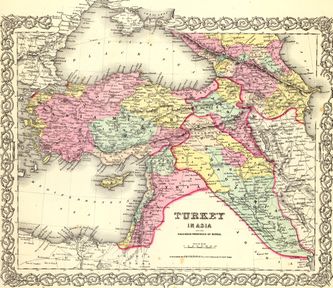
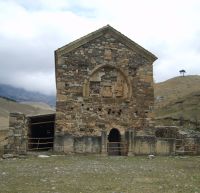
- 10,000–8000 ق.م.
- Migration of Nakh people to the slopes of the Caucasus from the Fertile Crescent. Invention of agriculture, irrigation, and the domestication of animals.[27][28]
- 6000–4000 ق.م.
- Neolithic era. Pottery is known to the region. Old settlements near Ali-Yurt and Magas, discovered in the modern times, revealed tools made out of stone: stone axes, polished stones, stone knives, stones with holes drilled in them, clay dishes etc. Settlements made out of clay bricks discovered in the plains. In the mountains, there were discovered settlements made out of stone surrounded by walls some of them dated back to 8000 BC.[29]
- 4000–3000 ق.م.
- Invention of the wheel (3000 BC), horseback riding, metal works (copper, gold, silver, iron) dishes, armor, daggers, knives, arrow tips. The artifacts were found near Nasare-Cort, Muzhichi, Ja-E-Bortz (also known as Surkha-khi), Abbey-Gove (also known as Nazran or Nasare).[29]
- 900 م – 1200 م
- المملكة في وسط القوقاز انقسمت إلى ألانيا وألانيا النبيلة (معروفة من الروسية Царственные Аланы). العالم الألماني Peter Simon Pallas believed that Ingush people (Kist) were the direct descendants from Alania.[30][31]
- 1239 م
- Destruction of the Alania capital of Maghas (both names known solely from Muslim Arabs) and Alan confederacy of the Northern Caucasian highlanders, nations, and tribes by Batu Khan (a Mongol leader and a grandson of Genghis Khan) "Magas was destroyed in the beginning of 1239 by the hordes of Batu Khan. Historically Magas was located at approximately the same place on which the new capital of Ingushetia is now built" – D.V.Zayats[32]
- 1300 م – 1400 م
- War between the Alans, Tamerlan, Tokhtamysh, and the Battle of the Terek River. The Alan tribes build fortresses, castles, and defense walls locking the mountains from the invaders. Part of the lowland tribes occupied by Mongols. The insurgency against Mongols begins. "One map of the area during the Mongol period gives us a clue why there was not much written about the Vainakh— as the area of Chechnya-Ingushetia on that map is simply marked as ‘‘ungovernable.’’ This is not surprising, as the majority of armies moving north or south would be interested in passing through the mountains and getting to their ultimate destinations as quickly as possible— leaving the peoples between the two passes relatively unmolested.” – Schaefer, Robert W. “Insurgency in Chechnya and the North Caucasus: From Gazavat to Jihad” p.51. In 1991 the Jordanian historian Abdul-Ghani Khassan presented the photocopy from old Arabic scripts claiming that Alania was in Chechnya and Ingushetia, and the document from Alanian historian Azdin Vazzar (1395–1460) who claimed to be from Nokhcho tribe of Alania.[33][34]
- 1500 م
- الاحتلال الروسي للقوقاز. 1558 Temryuk of Kabarda sends his emissaries to Moscow requesting help against Ingush tribes from Ivan the Terrible. Ivan the Terrible marries Temryuk's daughter Maria Temryukovna the Circassian (Kabardin) tsaritsa. Alliance formed to gain the ground in the central Caucasus for the expanding Tsardom of Russia against stubborn Vainakh defenders.
- القرن الثامن عشر
- After several attempts to gain the access of strategic Darial Gorge, Russian forces lose the battle near village Angusht. Hence the tribe which lived in the village and the nation as a whole is nicknamed Ingush.
الحروب القوقازية
Russian historians claim that the Ingush volunteered to become a part of Russia. This conclusion is based mostly on the document signed on 13 June, 1810, by General-Major Delpotso and representatives of 2 Ingush clans. Other clans resisted the Russian conquest. On June 29, 1832, Russian baron Rozen reported in letter No.42 to count Chernishev that "on the 23rd of this month I exterminated eight Ghalghai (Ingush) villages. On the 24th I exterminated nine more villages near Targim." By November 12, 1836 (letter no.560, he was claiming that highlanders of Dzheirkah, Kist, and Ghalghai had been temporarily conquered.[35] The Russian conquest was extremely difficult and the Russian forces began to rely on the method of colonization: extermination of the local population and repopulation of the area with Cossack and Ossetian loyalists. Colonization of Ingush land by Russians and Ossetians started in the middle of the 19th century. Russian General Evdokimov and Ossetian colonel Kundukhov in 'Opis no. 436' "gladly reported" that "the result of colonization of Ingush land was successful":
- Ingush village Ghazhien-Yurt was renamed to Stanitsa Assinovskaya in 1847.
- Ingush village Ebarg-Yurt was renamed to Stanitsa Troitskaya in 1847.
- Ingush town Dibir-Ghala was renamed to Stanitsa Sleptsovskaya in 1847.
- Ingush village Magomet-Khite was renamed to Stanitsa Voznesenskaya in 1847.
- Ingush village Akhi-Yurt was renamed to Stanitsa Sunzhenskaya in 1859.
- Ingush village Ongusht was renamed to Stanitsa Tarskaya in 1859.
- Ingush town Ildir-Ghala was renamed to Stanitsa Karabulakskaya in 1859.
- Ingush village Alkhaste was renamed to Stanitsa Feldmarshalskaya in 1860.
- Ingush village Tauzen-Yurt was renamed to Stanitsa Vorontsov-Dashkov in 1861.
- Ingush village Sholkhi was renamed to Khutor Tarski in 1867.[36]
After the losses, the remaining Ingush clans resorted mostly to underground resistance.[37] The Russians built the fortress Vladikavkaz ("ruler of the Caucasus") on the place of Ingush village of Zaur.[38][39][40][41][42][43][44][45][46] Russian General Aleksey Petrovich Yermolov wrote in a letter to the Tsar of Russia, "It would be a grave mistake for Russia to alienate such a militaristic nation as the Ingush." He suggested the separation of the Ingush and Chechens in order for Russia to win the war in the Caucasus. In another letter from General Ermolov to Lanski (dated 12 January 1827) on the impossibility of forceful Christianization of the Ingush, Yermolov wrote: "This nation, the most courageous and militaristic among all the highlanders, cannot be allowed to be alienated..." The last organized rebellion (the so-called "Nazran insurrection") in Ingushetia occurred in 1858 when 5,000 Ingush started a fight but lost to superior Russian forces. The rebellion signaled the end of the First Russo-Caucasian War. In the same year, the Russian Tsar encouraged the emigration of Ingush and Chechens to إيطاليا and the Middle East by claiming that "Muslims need to live under Muslim rulers". It seems that he wanted to liberate the land for Ossetians and Cossacks.[37] Some Ingush became exiled to deserted territory in the Middle East where many of them died. The remainder were assimilated. It was estimated that 80% of the Ingush left Ingushetia for the Middle East in 1865.[47][48]
After the Russian Revolution of 1917, the Soviets promised the Ingush that the villages and towns annexed during the colonization would be returned to the Ingush. Ingushetia becomes a major battleground between the old archenemies: general Denikin and Ingush resistance fighters. In his memoirs, general Denikin writes: "Ingush people are the least numerous, most welded, and strongly martial organization. They were, in essence, the supreme arbiter of the North Caucasus. The moral of the appearance was defined long ago in Russian text-books of geography, "the chief occupation – animal husbandry and robbery ..." The last one of the two reached special art in the society. Political aspirations came from the same trend. The Ingush are mercenaries of the Soviet regime, they support it but don't let the spread of it in their province. At the same time, they tried to strike up relations with إيطاليا and sought the assistance from the Turks from Elisavetpol, and Germany – from Tiflis. In August, when the Cossacks and Ossetians captured Vladikavkaz, the Ingush intervened and saved the Soviet Board of Commissioners of Terek, but sacked the city and captured the state bank and mint. They robbed all the neighbors: the Cossacks and Ossetians in the name of “correcting historical errors” for a shortage of land, the Bolsheviks – in return for their services, Vladikavkaz citizens – for their helplessness, and the Kabardins – just out of habit. They were hated by everyone, and they did their “craft” in unison, well organized, in a big way, becoming the richest tribe in the Caucasus.”[49]
جمهورية شمال القوقاز الجبلية
On December 21, 1917 Ingushetia, Chechnya, and Dagestan declared independence from Russia and formed a single state called the "United Mountain Dwellers of the North Caucasus" (also known as Mountainous Republic of the Northern Caucasus), which was recognized by Central Powers (Germany, Austro-Hungary and Turkey), Georgia, and Azerbaijan (which declared their independence from Russia in 1918) as an independent state.[50] For example, Anna Zelkina writes that in May 1918 the first country to recognize independence was Turkey:[51]
The First Congress of the North Caucasus formed a Provisional Government of the North Caucasian Free State (SeveroKavkazskoye Svobodnoye Gosudarstvo) and in May 1918 declared the establishment of the North Caucasian Republic. The only country to recognize it was Turkey.
Later Germany and others followed the recognition. According to P. Kosok:[52]
Azerbaidzhan and Armenia (May 28, 1918). All three states then concluded independent treaties with Turkey, which similarly acknowledged the independence of the Northern Caucasus and concluded a treaty of friendship with it on June 8, 1918. An exchange of diplomatic notes then took place between the head of the German Extraordinary Delegation, General von Lossov, and the North Caucasian Minister of Foreign Affairs, Bammat, resulting in the de facto recognition by Germany of the independence of the Northern Caucasus.
The capital of the new state was moved to Temir-Khan-Shura (Dagestan).[53][54][55] The first prime minister to be elected was Tapa Chermoyev, a Chechen prominent statesman; the second prime minister was Ingush statesman Vassan-Girey Dzhabagiev who also was the author of the Constitution of the land in 1917. In 1920 he was reelected for a third term. In 1921 Russians attacked and occupied the country and forcefully merged it with the Soviet state. The Caucasian war for independence continued and the government went into exile.[56]
الفترة السوڤيتية
The Soviets confiscated the remaining Ingush properties by collectivization and dekulakization[57] and unified Chechnya and Ingushetia into Chechen-Ingush ASSR.
During World War II Ingush youth were drafted into the Russian army. In August 1942, for three weeks, Nazi German forces captured half of the North Caucasus and were stopped only at two Ingush towns: Ordzhonikidze (modern-day Vladikavkaz) and Malgobek. The battle between Ingush and Germans intensified at Malgobek and the small town was captured and recaptured four times for another month until the Germans finally retreated. Stalin planned the expansion of the USSR in the south through Turkey. Muslim Chechens and Ingush could become a threat to the expansion.[58] In February 1944 near the end of World War II, Russian Army and NKVD units flooded the Chechen-Ingush ASSR. The maneuvers were disguised as military exercises of the southern district.
الإبادة العرقية 1944
أثناء الحرب العالمية الثانية، في 1942 German forces entered the North Caucasus. For three weeks Germans captured over half of the North Caucasus. They were only stopped at two Chechen-Ingush cities: Malgobek and Ordzhonikidze (a.k.a. "Vladikavkaz") by heroic resistance of natives of Chechen-Ingush ASSR.[59] Russian propaganda portrayed Chechens and Ingush as "traitors". On 23 February 1944 Ingush and Chechens were falsely accused of collaborating with the Nazis. As a result, an operation under the code name "Lentil" was carried out and the entire Ingush and Chechen populations were deported to Kazakhstan, Uzbekistan, and Siberia on the orders of Soviet leader Joseph Stalin while the majority of their men were fighting on the front. The initial phase of the deportation was carried out on United States-supplied Studebaker trucks specifically modified with three submachine gun nest compartments above the deported to prevent escapes. American historian Norman Naimark writes:
Troops assembled villagers and townspeople, loaded them onto trucks – many deportees remembered that they were Studebakers, fresh from Lend-Lease deliveries over the Iranian border – and delivered them at previously designated railheads. …Those who could not be moved were shot. …[A] few fighters aside, the entire Chechen and Ingush nations, 496,460 people, were deported from their homeland.[60]
The deportees were gathered on the railroad stations and during the second phase transferred to the cattle railroad carts. Up to 30% of the population perished during the journey or in the first year of the exile.[61][62][63] The Prague Watchdog claims that "in the early years of their exile about half of the Chechens and Ingush died from hunger, cold and disease".[64] The deportation was classified by the European Parliament in 2004 as genocide.[65] After the deportation Ingush resistance against Russia rises again. Those who escaped the deportation, shepherds who were high in the mountains, during the deportation combined forces and formed rebel groups which constantly attacked Russian forces in Ingushetia. Major rebel groups were led by Akhmed Khuchbarov, Tsitskiev brothers, and Ingush female sniper Laisat Baisarova. The last one of the male Ingush rebels was killed in 1977 by the KGB officers, while the female sniper Laisat Baisarova was never captured or killed.[66] American professor Johanna Nichols, who specializes in Chechen and Ingush philology, provided the theory behind the deportation:
In 1944 the nationalities themselves were abolished and their lands resettled when the Chechen and Ingush, together with the Karachay-Balkar, Crimean Tatars, and other nationalities were deported en masse to Kazakhstan and Siberia, losing at least one-quarter and perhaps half of their population in transit. (The reason, never clarified, seems to have been Stalin's wish to clear all Muslims from the main invasion routes in a contemplated attack on Turkey.)[67]
بعد العودة من آسيا الوسطى
After 13 years of exile, the Ingush were allowed to return to Chechen-Ingushetia (but not to Ordzhonikidze a.k.a. "Vladikavkaz" or the Prigorodny District). Most of Ingushetia's territory had been settled by Ossetians and part of the region had been transferred to North Ossetia. The returning Ingush faced considerable animosity from the Ossetians. The Ingush were forced to buy their homes back from the Ossetians and Russians. These hardships and injustices led to a peaceful Ingush protest in Grozny on 16 January 1973, which was crushed by the Soviet troops.[68] In 1989, the Ingush were officially rehabilitated along with other peoples that had been subjected to repressions.[69]
جزء من الاتحاد الروسي، فترة ما بعد الاتحاد السوڤيتي
In 1991, when the Chechens declared independence from the Soviet Union to form the Chechen Republic of Ichkeria, the Ingush chose to secede from the Chechen-Ingush Republic. Thus, in 1992 the Ingush joined the newly created Russian Federation to try to resolve the conflict with Ossetia peacefully, also in the hope that the Russians would return their land as a token of their loyalty.
التطهير العرقي في 1992
However, ethnic tensions in North Ossetia which were orchestrated by Ossetian nationalists (per Helsinki Human Right Watch), led to an outbreak of violence in the Ossetian–Ingush conflict in October-November 1992, when another ethnic cleansing of the Ingush population started.[70] According to media reports, Ingush hostages were held in 1992 in the Beslan high school gymnasium. The hostages were all kept in the same gymnasium, deprived of food and water. At least one newborn and several dozen male Ingush hostages were executed.[71][72][73][74] (In a possible retaliation in 2004, Chechen and Ingush militants took over 500 Ossetian hostages in Beslan high-school, the same building where Ossetian militants had held hundreds of Ingush hostages in 1992). Over 60,000 Ingush civilians were forced from their homes in the Prigorodny District of North Ossetia.[37] As a result of the conflict, pro-Russian general Ruslan Aushev, a decorated war hero from the War in Afghanistan, was appointed by the Russian government as the first president of Ingushetia to stop the spread of the conflict. Partial stability returned under his rule.
حربا الشيشان الأولى والثانية
In 1994, when the First Chechen War started, the number of refugees in Ingushetia from both conflicts doubled. According to the UN, for every citizen of Ingushetia, one refugee arrived from Ossetia or Chechnya. This influx was very problematic for the economy, which collapsed after Aushev's success. The second Russo-Chechen war which started in 1999 brought more refugees (at some point there was one refugee for every Ingush citizen: 240,000 from Chechnya plus 60,000 from North Ossetia at the peak in 2000) and misery to Ingushetia. In 2001, Aushev was forced to leave his presidency and was succeeded by Murat Zyazikov, a former KGB general. The situation worsened under his rule. Many young Ingush men were abducted by Russian and Ossetian death squads.[75][76][77][78] according to Human rights watchdogs Memorial[79] and Mashr.[80] The Ingush mountains are closed for Ingush nationals.[81] The number of rebel attacks in Ingushetia rose, especially after the number of Russian security forces was tripled. For example, according to a Russian news agency a murder of an ethnic-Russian school teacher in Ingushetia was committed by two ethnic-Russian and ethnic-Ossetian soldiers; Issa Merzhoev the Ingush Police detective who solved the crime was shot at and killed by "unknown" assailants shortly after he had identified the murderer.[82] At least four people were injured when a vehicle exploded on 24 March 2008. An upsurge in violence in these months targeted local police officers and security forces. In January 2008, the Federal Security Service of the Russian Federation launched a "counter-terrorism" operation in Ingushetia after receiving information that insurgents had been preparing a series of attacks.[83] In the beginning of August 2008, the war between Georgia and South Ossetia broke out, in which the Russian Federation subsequently became involved.[84] After the outbreak of the war, there were virtually no more attacks or abductions of Ingush civilians by "unknown" forces. Most of the Russian forces were transferred to North and South Ossetia[85] 31 August 2008 Magomed Yevloyev, the head of Ingush opposition and the owner of the website ingushetiya.ru, was killed by Russian security forces[86] Shortly before the unrecognised opposition group People's Parliament of Ingushetia Mekhk-Kkhel called for the recognition of the Russian semi-autonomous republic's independence, opposition activist Magomed Khazbiyev proclaimed, "We must ask Europe or America to separate us from Russia."[87][88]
On October 18, 2008, a Russian military convoy came under grenade attack and machine gun fire near Nazran. Official Russian reports of the ambush, which has been blamed on local Muslim separatists, said two soldiers were killed and at least seven injured. Reports from Ingush opposition sources suggested as many as forty to fifty Russian soldiers were killed.[89][90]
On October 30, 2008, Zyazikov was dismissed from his office (he himself claimed he resigned voluntarily). On the next day, Yunus-Bek Yevkurov was nominated by Dmitry Medvedev and approved as President by the People's Assembly of Ingushetia (later the title President was renamed to Head). This move was endorsed by major Russian political parties and by the Ingush opposition.[91][92] Under the current rule of Yevkurov, Ingushetia seems much calmer, showing some semblance of the Russian government. Attacks on policemen have fallen by 40% and abductions by 80%.[93]
التاريخ العسكري
According to professor Johanna Nichols, in all the recorded history and reconstructable prehistory, the Ingush people have never undertaken battle except in defense.[37] In the 3rd and 2nd centuries BC Pharnavaz, his son Saurmag the Iberian kings, and the relatives of Ingush people per Leonti Mroveli, received military assistance from Ingush people in defense of Iberia against the Kartli occupation.[94]
During World War I, 500 cavalrymen from an Ingush regiment of the Wild Division attacked the German Iron Division. The Russian Emperor Nicholas II, assessing the performance of the Ingush and Chechen regiments during the Brusilov breakthrough on the Russian-German front in 1915 wrote in a telegram to the Governor-General of the Tersky region Fleisher:
The Ingush regiment pounced upon the German "Iron Division" like an avalanche. It was immediately supported by the Chechen regiment. The Russian history, including the history of our Preobrazhensky regiment, does not know a single instance of a horse cavalry attacking an enemy force armed with heavy artillery: 4.5 thousand killed, 3.5 thousand taken prisoner, 2.5 thousand wounded. Less than in an hour and a half the "Iron Division" ceased to exist, the division that had aroused fear in the best armies of our allies. On behalf of me, the royal court and the whole of the Russian army send our best regards to fathers, mothers, sisters, wives and brides of those brave sons of the Caucasus whose heroism paved the way for the destruction of German hordes. Russia bows low to the heroes and will never forget them. I extend my fraternal greetings, Nicholas II, August 25, 1915.[95]
In 1941, when Germans attacked the USSR, the whole Russian front was retreating 40 km a day. Out of 6,500 defenders of Brest Fortress, 6,000 Soviet troops capitulated. 500 troops were fresh conscripts of Ingush and Chechen origin. Defenders held the fortress for over a month against the Germans and even managed to stage several attacks from the Fortress. The last defender's name has been unknown for a long time; his documents identified him as a man called Barkhanoyev. Decades later, official records revealed it was Umatgirei Barkhanoyev from the Ingush village of Yandare. Recently, the memoirs of Stankus Antanas, a Lithuanian national and former Waffen SS officer, were published in Ingushetia. He recalls that in July 1941, his regiment was ordered to "finish off" the remaining Soviet soldiers in the fortress. When the Nazis decided that no defenders had been left alive, an SS general lined up his soldiers on the parade ground to award them with decorations for capturing the fortress. Then, a Red Army officer came out from the fortress's underground bunker:
He was blind because of his wounds and walked with his left arm extended forward. His right hand rested on a gun holster. He walked along the parade grounds wearing a ragged uniform, but his head was held high. The entire division was shocked at the sight. Approaching a shell-hole, he turned his face toward the west. The German general suddenly saluted this last defender of the Brest Fortress, and the rest of the officers followed suit. The Red Army officer drew a handgun and shot himself in the head. He fell on the ground facing Germany. A deep-drawn sigh aired over the parade grounds. We all stood 'frozen' in awe of this brave man.[96]
In 1994–96 Ingush volunteers fought alongside Chechens in the First Chechen War. Aside from a few incidents (including the killings of Ingush civilians by Russian soldiers), Ingushetia was largely kept out of the war by a determined policy of non-violence pursued by President Ruslan Aushev.[37]
This changed after the beginning of the Second Chechen War, and especially since Murat Zyazikov became the second Russian appointed president of Ingushetia in 2002. The first major rebel attack of the conflict, in which a military convoy was destroyed occurred in May 2000 and caused the deaths of 19 soldiers. In the June 2004 Nazran raid, Chechen and Ingush rebels attacked government buildings and military bases across Ingushetia, resulting in the deaths of at least 90 Ingush people and an unknown number of Russian troops. Among them the Republic's acting interior minister Abukar Kostoyev, his deputy Zyaudin Kotiyev. In response to a sharp escalation in attacks by insurgents since the summer of 2007,[97] Moscow sent in an additional 25,000 MVD and FSB troops, tripling the number of special forces in Ingushetia.
الاضطراب المدني
- 1800s–1860s: Insurgency against Russian conquest.
- 1860s–1890s: Raids of Ingush abreks on the Georgian Military Highway and Mozdok.
- 1890s–1917: Insurgency of Ingush resistance under Chechen abrek Zelimkhan Gushmazukaev and Ingush abrek Sulom-beck Sagopshinski, execution of Russian viceroy to Ingushetia colonel Mitnik by Ingush resistance fighter Buzurtanov.
- 1917–1920s: Insurgency of Ingush resistance fighters against combined Russian White Guards, Cossacks, Ossetians, and general Denikin forces.
- 1920s–1930s: Insurgency of Ingush people against Communists, executions of Communist leader of Ingushetia Chernoglaz by Ingush rebel Uzhakhov. Execution of Communist party leader of Ingushetia Ivanov by Ingush rebels.
- 1944–1977: Ingush rebels avenging the deportation of the Ingush nation. Scores of Russian army units and NKVD, KGB officers killed.
- 1992: Ossetian-Ingush conflict. In combat operations Ingush rebels capture armor which later transferred to Chechens or given back to Russian army after the conflict ended.
- 1994: Nazran. Ingush civilians stop Russian army, flip armor, burn military trucks which were on the march to Chechnya in Russian-Chechen war. First Russian casualties reported from hands of Ingush rebels.
- 1994–1996: Ingush rebels defend Grozny and participate in combat operations on Chechen side.
- 1999–2006: Ingush rebels join Chechen rebels, the independence war turns into Jihad.
- 13 July 2001: Ingush people protest "defiling and desecration" of historical Christian Ingush church Tkhaba-Yerdy after Russian troops made the church into a public toilet. Though Ingush are Muslims they highly respect their Christian past.[98]
- 15 September 2003: Ingush rebels use bomb truck and attack FSB headquarters in Maghas. Several dozens of Russian FSB officers killed including the senior officer overseeing the FSB in Chechen republic. The several story HQ building is severely damaged.[99]
- 6 April 2004: Ingush rebels attack Russian appointed president of Ingushetia Murat Zyazikov. He was wounded when a car bomb was rammed into his motorcade.
- 22 June 2004: Chechen and Ingush rebels raid on Russian troops in Ingushetia. Hundreds of Russian troops killed.
- 31 August 2008: Execution of Magomed Yevloyev Ingush dissident, journalist, lawyer, businessman, and the owner of the news website Ingushetiya.ru, known for being highly critical of Russian regime in Ingushetia. He was shot in the head.[100] Awarded posthumously, and his name is engraved in stone on the monuments at the Journalists' Memorials in Bayeux, France and Washington D.C., the United States.[101]
- 30 September 2008: A suicide bomber attacked the motorcade of Ruslan Meiriyev, Ingushetia's top police official.
- 10 June 2009: Snipers killed Aza Gazgireyeva, deputy chief justice of the regional Supreme Court, as she dropped her children off at school. Russian news agencies also cited investigators as saying she was likely killed for her role in investigating the 2004 attack on Ingush police forces by Chechen fighters.[102]
- 13 June 2009: Two gunmen sprayed former deputy prime minister Bashir Aushev with automatic-weapon fire as he got out of his car at the gate outside his home in the region's main city, Nazran.[103]
- 22 June 2009: Russian appointed president of Ingushetia Yunus-Bek Yevkurov was badly hurt when a suicide bomber detonated a car packed with explosives as the president's convoy drove past. The attack killed three bodyguards.[104]
- 12 August 2009: Gunmen killed construction minister Ruslan Amerkhanov in his office in the Ingush capital, Magas.[105]
- 17 August 2009: A suicide bomber killed 21 Ingush police officers and unknown numbers of Russian Internal Ministry troops which were stationed in Nazran, after he drove a truck full of explosives into a MVD police base.
- 25 October 2009: Execution of Maksharip Aushev, an Ingush businessman, dissident, and a vocal critic of Russian regime policies in Ingushetia. His body had over 60 bullet holes. Awarded posthumously by the U.S. Department of State in 2009.[106]
- 5 April 2010: A suicide bomber injured three police officers in the town of Karabulak. Two officers died at the hospital as a result of their injuries. While investigators arrived on scene, another car bomb was set off by remote. Nobody was hurt in the second blast.[107]
- 24 January 2011: A suicide bomber, Magomed Yevloyev (same first and last name as the slain Ingush opposition journalist Magomed Yevloyev), killed 37 people at Domodedovo airport, Moscow, Russia.
- 2012: Ingush rebels participate in war against Assad, Iranian, and Russian advisors in Syria which is largely viewed by the Ingush rebels as war against Russia and the Iranian-speaking Ossetians. The rebel Ingush commanders are veterans of Ossetian-Ingush conflict, wars in Chechnya, Daud Khalukhayev from Ingush village of Palanazh (Katsa), and a descendant of Ingush deportees of 1860's Syrian-born Ingush Walid Didigov.[108][109]
- 6 June 2013: Accusation of Ingush rebel leader Ali "Maghas" Taziev in Rostov-On-Don regional Russian court, who was captured after he voluntarily given himself up in on 9 June 2010 to Russian forces in Ingushetia on the agreement that Russians will liberate his relatives held hostage on one of the Russian military bases.
- 27 August 2013: Execution of the head of security of Ingushetia Akhmet Kotiev and his bodyguard by Ingush rebels. Kotiev was actively involved in the assassination of Magomed Yevloyev.
- 10 December 2013: Ingush opposition leader Magomed Khazbiev, who was a close friend of assassinated Magomed Yevloyev, attends Euromaidan in Ukraine and participates in anti-Russian campaign there after which his parents were threatened and harassed in Russia. On his website he writes: "the fact that Putin's slaves harass my parents do not make any sense, if you [Russians] want me to stop you have to kill me like Magomed Yevloyev and Makhsharip Aushev".[110]
- 2 February 2014: Russian FSB officially confirms that in the middle of December 2013 four North Caucasian instructors operate in Ukraine, and prepare Ukrainians for street battles against Russian interests.[111]
- 20 April 2014: Famous Ingush human rights defender Ibrgim Lyanov stated that Ingushetia wants to separate from Russia and become an independent state using the example of the Crimean separation from Ukraine.[112]
- 24 May 2014: Ingush rebel leader Arthur Getagazhev, 4 rebels, and 2 civilians were killed in action in the village of Sagopshi by Russian forces.[113]
- 2 July 2014: After several months of denial, pro-Russian president of Ingushetia finally recognizes that Ingush rebels are fighting in Ukraine against pro-Russia forces.[114]
- 2 July 2014: Ingush rebels attack Russian armored military convoy killing 1 and wounding 7 soldiers.[115]
- 6 July 2014: Russian special forces prepared an ambush near the morgue in Nazran hospital where the body of Arthur Getagazhev was located. The intelligence reported that Ingush rebels will try to recover the body of the slain leader. The intelligence was correct. Radio Free Europe (section specializing in the Caucasus), reports that in the middle of the day 2 Ingush rebels attacked the ambush, according to unofficial source two rebels killed 7 and wounded 4 Russian FSB and spetsnaz officers in less than 40 seconds, after which the rebels left the scene unharmed. The source in Ingush police who wanted to stay anonymous said that exact number of killed are known only by the FSB but nobody would dare to declare if officially.[116] According to pro-Kremlin LifeNews released video the attack lasted less than 19 seconds.[117]
- 17 January 2015: Maghas. Rise of anti-Western sentiments. Over 20,000 Ingush citizens protest against European terrorism toward Muslims.[118][119]
- 28 February 2015: Russian opposition leader Nemtsov's death linked to Ingushetia by Russian police.[120][121]
الآثار
تضم جمهورية إنگوشتيا إحدى ابرز المحميات الأثرية في منطقة القوفاز، حيث تتوزع عشرات النصب والأبراج والقلاع المعمارية التاريخية على سلسلة جبال إنگوشتيا، وفي سهل تاغيسكي، ووادي نهر ارمخا، وفي منطقة أسا الجبلية. ومن ابرز هذه المعالم الأثرية معبد البيردي ومعبد طحابيردي، ومجمع قلاع فوفنوشكي ومجمعات حمحي وتارغيم وإيغكال وغيرها من المواقع التي تغني تلك المنطقة وتجعلها شاهدا على الحضارات التي مرت عبر العصور، كما أنها تعكس المراحل التاريخية لفن البناء لدى سكان تلك المنطقة، مما يجعل لهذه المعالم قدسية لدى السكان الحاليين.
العادات والتقاليد
أبرز ما يشتهر به الإنگوش هو التقاليد والعادات التي يحافظون عليها على مر السنين، ومنها ان أي إنسان يمكن أن يحل عليهم ضيفا بغض النظر عن قوميته وديانته، فبمجرد دخوله المنزل يصبح ضيفا مرحبا به ويقدم له الطعام ومن ثم كل وسائل الراحة والحماية اللازمة، وبعد ذلك يسأل المضيف الضيف عن سبب زيارته. إلى جانب هذه الميزة، لدى الإنگوش ميزة لا تقل أهمية وهي الاهتمام الدائم بالوالدين واحترامهما، واحترام من هو أكبر سنًا وخصوصا عند الكلام، إذ يجب بحسب التقاليد الإنگوشية الاستماع حتى النهاية إلى حديث من هو أكبر سنا ومن ثم السؤال منه عن إمكانية الإجابة أو المشاركة بالحديث. كما وأن الإنگوش من أكثر شعوب القوقاز التي لا تزال تحافظ على اللباس القومي وخصوصا في المناطق الجبلية.
التقسيمات الادارية
- المدن في جمهورية إنگوشتيا (كما في 2016):
- المقاطعات:
العاصمة مگس
 مقالة مفصلة: مگس
مقالة مفصلة: مگس
تجربة بناء العاصمة الإنگوشية الجديدة ماگاس هي التجربة الأولى في تاريخ روسيا الحديث منذ ولاية القيصر بطرس الأكبر الذي نقل العاصمة الروسية من موسكو إلى پطرسبورگ، وكانت تلك من التجارب المعمارية الناجحة في تاريخ روسيا حيث تعتبر مدينة بطرسبورگ من أجمل المدن في العالم بالرغم من عودة العاصمة إلى مدينة موسكو بعد انتصار الثورة البلشفية .
تشهد العاصمة الإنگوشية الحديثة ماگاس اليوم نهضة عمرانية تتمثل بانتشار الابنية الحكومية والسكنية والإدارية على ضفاف نهر سونجا لتشكل سلسلة حلقات متشابهة ومترابطة، إضافة إلى سكك الحديد التي تربطها بالمناطق المجاورة، ومطار يبعد حوالي 30 كيلومترا عن وسط العاصمة، والطريق الدولية المعروفة بطريق القوقاز التي تربط مدينة روستوف الروسية بالعاصمة الاذربيجانية باكو، إضافة إلى انطلاق عملية شق طريق جديدة تصل بين ماگاس وجورجيا.
ولعل أجمل الابنية في ماگاس هو مجمع الدوائر الحكومية والدبلوماسية والتجارية والإعلامية، إلى جانب المركز الروحي للمدينة الذي يتمثل بالمسجد والمدرسة الدينية.
واللافت في ماگاس الحديثة هو الإبداع المعماري الذي يجمع بين الفن المعماري العالمي الحديث وفن البناء الروسي في صورة تعكس التقليد المعماري للإنگوش.
نزران
 مقالة مفصلة: نزران
مقالة مفصلة: نزران
نزران العاصمة السابقة وثاني المدن الانگوشية الكبرى، وحاليا تشكل العصب الأساسي للاقتصاد المحلي، وتنتشر فيها الاسواق التجارية، والمطاعم والمقاهي وبعض الفنادق ،بالأضافة إلى المحلات والمراكز التجارية على أنواعها، مما يجعل هذه المدينة أكثر حيوية من بقية المدن الإنگوشية وأكثر كثافة سكانية لا سيما وان فرص العمل الأساسية تتوفر في هذه المدينة ،على عكس المدن والبلدات الإنگوشية الأخرى التي تعاني من ازمة البطالة التي تتجاوز معدلاتها 50 % من السكان القادرين على العمل
الديمغرافيا
التعداد: 412,529 (تعداد 2010);[12] 467,294 (تعداد 2002).[123]
The Ingush, a nationality group indigenous to the Caucasus, mostly inhabit Ingushetia. They refer to themselves as Ghalghai (from Ingush: Ghala ("fortress" or "town") and ghai ("inhabitants" or "citizens"). The Ingush speak the Ingush language, which has a very high degree of mutual intelligibility with neighboring Chechen.
الإحصائيات الحيوية
| Average population (× 1000) | Live births | Deaths | Natural change | Crude birth rate (per 1000) | Crude death rate (per 1000) | Natural change (per 1000) | Total fertility rate | |
|---|---|---|---|---|---|---|---|---|
| 1995 | 273 | 6,889 | 1,867 | ▲ 5,022 | 25.3 | 6.8 | 18.4 | |
| 1996 | 287 | 5,980 | 1,958 | ▲ 4,022 | 20.9 | 6.8 | 14.0 | |
| 1997 | 294 | 6,055 | 1,957 | ▲ 4,098 | 20.6 | 6.7 | 14.0 | |
| 1998 | 299 | 5,929 | 2,064 | ▲ 3,865 | 19.8 | 6.9 | 12.9 | |
| 1999 | 321 | 6,624 | 1,953 | ▲ 4,671 | 20.6 | 6.1 | 14.6 | |
| 2000 | 393 | 8,463 | 2,117 | ▲ 6,346 | 21.5 | 5.4 | 16.2 | |
| 2001 | 450 | 8,753 | 1,875 | ▲ 6,878 | 19.4 | 4.2 | 15.3 | |
| 2002 | 461 | 7,578 | 1,874 | ▲ 5,704 | 16.4 | 4.1 | 12.4 | |
| 2003 | 463 | 7,059 | 1,785 | ▲ 5,274 | 15.3 | 3.9 | 11.4 | |
| 2004 | 454 | 6,794 | 1,751 | ▲ 5,043 | 15.0 | 3.9 | 11.1 | |
| 2005 | 446 | 6,777 | 1,821 | ▲ 4,956 | 15.2 | 4.1 | 11.1 | |
| 2006 | 437 | 7,391 | 1,830 | ▲ 5,561 | 16.9 | 4.2 | 12.7 | |
| 2007 | 430 | 8,284 | 1,625 | ▲ 6,659 | 19.3 | 3.8 | 15.5 | |
| 2008 | 423 | 9,215 | 1,561 | ▲ 7,654 | 21.8 | 3.7 | 18.1 | |
| 2009 | 418 | 9,572 | 1,877 | ▲ 7,695 | 22.9 | 4.5 | 18.4 | 2.51 |
| 2010 | 410 | 11,178 | 1,857 | ▲ 9,321 | 27.1 | 4.5 | 22.6 | 2.99 |
| 2011 | 423 | 11,408 | 1,705 | ▲ 9,703 | 27.0 | 4.0 | 23.0 | 2.94 |
| 2012 | 436 | 9,350 | 1,595 | ▲ 7,755 | 21.4 | 3.7 | 17.7 | 2.27 |
| 2013 | 447 | 9,498 | 1,568 | ▲ 7,930 | 21.2 | 3.5 | 17.7 | 2.23 |
| 2014 | 458 | 9,858 | 1,586 | ▲ 8,272 | 21.5 | 3.5 | 18.0 | 2.28 |
| 2015 | 469 | 8,674 | 1,557 | ▲ 7,117 | 18.6 | 3.3 | 15.3 | 1.97 |
| 2016 | 477 | 8,143 | 1,555 | ▲ 6,588 | 17.1 | 3.3 | 13.8 | 1.87 (estimate) |
| 2017 | 484 | 8,000 | 1,554 | ▲ 6,446 | 16.5 | 3.2 | 13.3 | |
| 2018 | 490 | 7,737 | 1,495 | ▲ 6,242 | 15.8 | 3.0 | 12.8 |
Note: Total fertility rate 2009, 2010, 2011 source:[124]
الجماعات العرقية
According to the 2010 Russian Census (2010),[12] ethnic Ingush make up 94.1% of the republic's population. Other groups include Chechens (4.6%), Russians (0.8%), and a host of smaller groups, each accounting for less than 0.5% of the total population.
| Ethnic group |
1926 Census | 1939 Census | 1959 Census | 1970 Census | 1979 Census | 1989 Census | 2002 Census | 2010 Census1 | ||||||||
|---|---|---|---|---|---|---|---|---|---|---|---|---|---|---|---|---|
| Number | % | Number | % | Number | % | Number | % | Number | % | Number | % | Number | % | Number | % | |
| Ingushes | 47,280 | 61.6% | 79,462 | 58.0% | 44,634 | 40.6% | 99,060 | 66.0% | 113,889 | 74.2% | 138,626 | 74.5% | 361,057 | 77.3% | 385,537 | 94.1% |
| Chechens | 2,553 | 3.3% | 7,746 | 5.7% | 5,643 | 5.1% | 8,724 | 5.8% | 9,182 | 6.0% | 19,195 | 10.3% | 95,403 | 20.4% | 18,765 | 4.6% |
| Russians | 24,185 | 31.5% | 43,389 | 31.7% | 51,549 | 46.9% | 37,258 | 24.8% | 26,965 | 17.6% | 24,641 | 13.2% | 5,559 | 1.2% | 3,321 | 0.8% |
| Ukrainians | 1,501 | 2.0% | 1,921 | 1.4% | 1,763 | 1.6% | 1,068 | 0.7% | 687 | 0.4% | 753 | 0.4% | 189 | 0.0% | 2,009 | 0.5% |
| Others | 1,215 | 1.6% | 4,549 | 3.3% | 6,438 | 5.9% | 3,978 | 2.7% | 2,852 | 1.9% | 2,781 | 1.5% | 5,086 | 1.1% | ||
| 1 2,897people were registered from administrative databases, and could not declare an ethnicity. It is estimated that the proportion of ethnicities in this group is the same as that of the declared group.[125] | ||||||||||||||||
الدين
The Ingush are predominantly Shafi'i Madhhab of Sunni Islam[127] with a Sufi minority, which is often associated with one of two traditional Sufi orders: the Sufi tariqa Naqshbandi, represented in Ingushetia by the brotherhood of Deni Arsanov, and the tariqa Qadiriyyah, associated with Kunta-Haji Kishiev.[128]
الجغرافيا
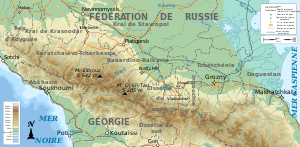
Ingushetia is situated on the northern slopes of the Caucasus. Its area is reported by various sources as either 2،000 متر كيلومربع (770 sq mi)[5] or 3،600 متر كيلومربع (1،400 sq mi);[129] the difference in reporting is mainly due to the inclusion or exclusion of parts of Sunzhensky Districts. The republic borders North Ossetia–Alania (SW/W/NW/N), the Chechnya (NE/E/SE), and the country of Georgia (Mtskheta-Mtianeti) (southwards). The highest point is the Gora Shan[130] (4451 m).
A 150-كيلومتر (93 mi) stretch of the Caucasus Mountains runs through the territory of the republic.
Rivers
Major rivers include:
المصادر الطبيعية
Ingushetia is rich in marble, timber, dolomite, plaster, limestone, gravel, granite, clay, thermal medical water, rare metals, mineral water, oil (over 60 billion tons), and natural gas reserves.
المناخ
Ingushetia's climate is mostly continental.
- Average January temperature: −10 °C (14 °F)
- Average July temperature: 21 °C (70 °F)
- Average annual precipitation: 450–650 mm (18–26 in)
- Average annual temperature: +10 °C (50 °F)
الهامش
- ^ Президент Российской Федерации. Указ №849 от 13 мая 2000 г. «О полномочном представителе Президента Российской Федерации в федеральном округе». (President of the Russian Federation. Decree #849 of May 13, 2000 On the Plenipotentiary Representative of the President of the Russian Federation in a Federal District).
- ^ Госстандарт Российской Федерации. №ОК 024-95 27 декабря 1995 г. «Общероссийский классификатор экономических регионов. 2. Экономические районы», в ред. Изменения №5/2001 ОКЭР. (گوستاندارت of the Russian Federation. #OK 024-95 December 27, 1995 Russian Classification of Economic Regions. 2. Economic Regions, as amended by the Amendment #5/2001 OKER).
- ^ أ ب Constitution, Article 64.1
- ^ Echo of Moscow. У Ингушетии сегодня появился новый президент. Им стал Юнус-Бек Евкуров, 31.10.2008
- ^ أ ب Федеральная служба государственной статистики (Federal State Statistics Service) (2004-05-21). "Территория, число районов, населённых пунктов и сельских администраций по субъектам Российской Федерации (Territory, Number of Districts, Inhabited Localities, and Rural Administration by Federal Subjects of the Russian Federation)". Всероссийская перепись населения 2002 года (All-Russia Population Census of 2002) (in الروسية). Federal State Statistics Service. Retrieved 2011-11-01.
- ^ Russian Federal State Statistics Service (2011). "Всероссийская перепись населения 2010 года. Том 1". Всероссийская перепись населения 2010 года (2010 All-Russia Population Census) (in Russian). Federal State Statistics Service. Retrieved June 29, 2012.
{{cite web}}: Invalid|ref=harv(help); Unknown parameter|trans_title=ignored (|trans-title=suggested) (help)CS1 maint: unrecognized language (link) - ^ "Об исчислении времени". Официальный интернет-портал правовой информации (in الروسية). 3 June 2011. Retrieved 19 January 2019.
- ^ الرسمية في جميع أرجاء روسيا الاتحادية حسب الفقرة 68.1 من دستور روسيا.
- ^ Constitution, Article 14
- ^ Law of June 4, 1992
- ^ Official website of the Republic of Ingushetia. Social-Economic Characteristics (بالروسية)
- ^ أ ب ت Russian Federal State Statistics Service (2011). "Всероссийская перепись населения 2010 года. Том 1". Всероссийская перепись населения 2010 года (2010 All-Russia Population Census) (in Russian). Federal State Statistics Service. Retrieved June 29, 2012.
{{cite web}}: Invalid|ref=harv(help); Unknown parameter|trans_title=ignored (|trans-title=suggested) (help)CS1 maint: unrecognized language (link) - ^ "Russia's North Caucasus Insurgency Widens as ISIS' Foothold Grows". www.worldpoliticsreview.com (in الإنجليزية). Retrieved 2017-10-03.
Russia's North Caucasus insurgency has gone relatively quiet, but reduced casualty numbers belie a still-worrying situation where long-standing grievances remain.
- ^ Walker, Shaun (2017-04-04). "Why suspicion over St Petersburg metro attack is likely to fall on Islamist groups". The Guardian (in الإنجليزية البريطانية). ISSN 0261-3077. Retrieved 2017-10-03.
A renewed crackdown on any suspected militant activity in the run-up to the Sochi winter Olympics in 2014 and the departure of many militants to fight in Syria led to a weakening of the North Caucasus insurgency.
- ^ "Ingushetia's cycle of violence". BBC. October 3, 2009. Retrieved January 7, 2011.
- ^ Urgent Need for Vigorous Monitoring in the North Caucasus. Human Rights Watch/Reuters, April 15, 2008. (archive link)
- ^ People & Power – Ingushetia: A second Chechnya – October 28, 2009, Al Jazeera English at YouTubeAl Jazeera English on YouTube (dead link)
- ^ Khasan Sampiev. "The Land of Towers". Archived from the original on فبراير 26, 2009.
{{cite web}}: Unknown parameter|deadurl=ignored (|url-status=suggested) (help) - ^ The work of Leonti Mroveli: "The history of the Georgian Kings"dealing with the history of Georgia and the Caucasus since ancient times to the 5th century AD, is included in medieval code of Georgian annals "Kartlis Tskhovreba".
- ^ "Caucasian Knot | An Essay On the History of the Vainakh People. On the origin of the Vainakhs". Eng.kavkaz-uzel.ru. Retrieved November 3, 2012.
- ^ "Microsoft Word - 4C04B861-0826-0853BD.doc" (PDF). Archived from the original (PDF) on February 25, 2012. Retrieved November 3, 2012.
{{cite web}}: Unknown parameter|deadurl=ignored (|url-status=suggested) (help) - ^ "G.F.Debets". Archived from the original on 2006-09-27.
{{cite web}}: Unknown parameter|dead-url=ignored (|url-status=suggested) (help) - ^ "Peering Into the Past, With Words".;Bernice Wuethrich, "Science" 2000: Vol. 288 no. 5469 p. 1158
- ^ Oleg Balanovsky, Khadizhat Dibirova, Anna Dybo, Oleg Mudrak, Svetlana Frolova, Elvira Pocheshkhova, Marc Haber, Daniel Platt, Theodore Schurr, Wolfgang Haak, Marina Kuznetsova, Magomed Radzhabov, Olga Balaganskaya, Alexey Romanov, Tatiana Zakharova, David F. Soria Hernanz, Pierre Zalloua, Sergey Koshel, Merritt Ruhlen, Colin Renfrew, R. Spencer Wells, Chris Tyler-Smith, Elena Balanovska, and The Genographic Consortium Parallel Evolution of Genes and Languages in the Caucasus Region Mol. Biol. Evol. 2011 : msr126v1-msr126
- ^ Ivane Nasidze; et al. (2001). "Alu insertion polymorphisms and the genetic structure of human populations from the Caucasus". European Journal of Human Genetics. 9 (4): 267–272. doi:10.1038/sj.ejhg.5200615. PMID 11313770.
- ^ Nasidze I, Risch GM, Robichaux M, Sherry ST, Batzer MA, Stoneking M (April 2001). "Alu insertion polymorphisms and the genetic structure of human populations from the Caucasus" (PDF). Eur. J. Hum. Genet. 9 (4): 267–72. doi:10.1038/sj.ejhg.5200615. PMID 11313770.
{{cite journal}}: CS1 maint: multiple names: authors list (link) - ^ Bernice Wuethrich (19 May 2000). "Peering Into the Past, With Words". Science. 288 (5469): 1158. doi:10.1126/science.288.5469.1158.
- ^ "Вайнахи самый древний народ в России". YouTube. 2012-02-10. Retrieved 2014-02-28.
- ^ أ ب N.D. Kodzoev. History of Ingush nation.
- ^ Броневский, Семен (July 20, 2017). "Новѣйшия географическия и историческия извѣстия о Кавказѣ". В Тип. С. Скливановскаго – via Google Books.
- ^ "Авторские Материалы". Archived from the original on 2008-02-17. Retrieved 2014-02-28.
{{cite web}}: Cite has empty unknown parameter:|dead-url=(help) - ^ D.V.Zayats (2001). "Maghas – "The Sun City" – New Capital of Ingushetia". Archived from the original on May 2, 2013.
{{cite journal}}: Cite journal requires|journal=(help) - ^ "Аланский историк из чеченцев". Chechenews.com. أغسطس 29, 2010. Archived from the original on ديسمبر 30, 2013. Retrieved فبراير 28, 2014.
{{cite web}}: Unknown parameter|deadurl=ignored (|url-status=suggested) (help) - ^ Категория: Мировая история. "Аланский историк". 95live.ru. Retrieved 2014-02-28.
- ^ Албогачиева М. "Многоликая Ингушетия". Groznycity.ru. Retrieved 2014-02-28.
- ^ "Немного о истории Владикавказа - часть 2 - 6 Января 2011 - История геноцида Ингушского|Чеченского народа". Vainax.ru. يناير 6, 2011. Archived from the original on مارس 5, 2014. Retrieved فبراير 28, 2014.
{{cite web}}: Unknown parameter|deadurl=ignored (|url-status=suggested) (help) - ^ أ ب ت ث ج Johanna Nichols (February 1997). "The Ingush (with notes on the Chechen): Background information". University of California, Berkeley. Archived from the original on December 8, 2006. Retrieved 2007-02-10.
{{cite web}}: Unknown parameter|deadurl=ignored (|url-status=suggested) (help) - ^ P.G.Butkov. Materials of the new history of the Caucasus years 1722–1803 St. Petersburg 1869 (page 165).
- ^ E.Bronevski. New geographical and historical perspectives of the Caucasus. Moscow, 1823 (vol.2 page 159).
- ^ U. Klaprot. Travel in the Caucasus and Georgia 1807–1808. Berlin 1812 (page 651).
- ^ N.Grabovski. Ingush nation (their life and traditions) Tiflis 1876 (page 2).
- ^ K.Raisov. New illustrated guide in the Crimea and the Caucasus. Odessa 1897 (page 295).
- ^ G.G. Moskvitch. Illustrated practical guide in the Caucasus. Odessa 1903 (pages 161–162).
- ^ N.M. Suetin. Geodesy of the Vladikavkaz. Vladikavkaz 1928 (page 12).
- ^ V.P. Khristianovich. Mountainous Ingushetia Rostov-on-Don 1928 (page 65).
- ^ E.I.Krupnov. Middle age Ingushetia Moscow, 1971 (page 166).
- ^ "Caucasus and central Asia newsletter. Issue 4" (PDF). University of California, Berkeley. 2003. Archived from the original (PDF) on February 27, 2008.
{{cite web}}: Unknown parameter|deadurl=ignored (|url-status=suggested) (help) - ^ "Chechnya: Chaos of Human Geography in the North Caucasus, 484 BC – 1957 AD". www.semp.us. نوفمبر 2007. Archived from the original on ديسمبر 20, 2010.
{{cite web}}: Unknown parameter|deadurl=ignored (|url-status=suggested) (help) - ^ Denikin, Anton Ivanovich (1925). Ocherki Russkoi Smuti.
- ^ MINORITY RIGHTS GROUP INTERNATIONAL, THE NORTH CAUCASUS:Minorities at a Crossroads
- ^ Anna Zelkina, Religion, State and Society, Vol. 21, No. I, 1993
- ^ "Revolution and Sovietization in the North Caucasus" “Caucasian Review”, 1955, No. 1, pp.47-54. No. 3, pp.45-53
- ^ http://1900.ethnia.org/polity.php?ASK_CODE=KC__&ASK_YY=1919&ASK_MM=05&ASK_DD=07&SL=en
- ^ Ben Cahoon. "Russian Civil War Polities". Worldstatesmen.org. Retrieved 2014-02-28.
- ^ "Общественное движение ЧЕЧЕНСКИЙ КОМИТЕТ НАЦИОНАЛЬНОГО СПАСЕНИЯ". Savechechnya.com. يونيو 24, 2008. Archived from the original on فبراير 23, 2014. Retrieved فبراير 28, 2014.
{{cite web}}: Unknown parameter|deadurl=ignored (|url-status=suggested) (help) - ^ "Вассан-Гирей Джабагиев". Vainah.info. Archived from the original on February 21, 2014. Retrieved 2014-02-28.
{{cite web}}: Unknown parameter|deadurl=ignored (|url-status=suggested) (help) - ^ "Spetspereselentsi: history of mass repressions and deportations of Ingushes in 20th century". Ingushetiya news agency. مارس 2005. Archived from the original on أكتوبر 19, 2007.
{{cite web}}: Unknown parameter|deadurl=ignored (|url-status=suggested) (help) - ^ "The Ingush People". Linguistics.berkeley.edu. 1992-11-28. Retrieved 2014-08-07.
- ^ "Через 63 года в отношении защитников Малгобека восстановлена историческая справедливость". Российская газета.
- ^ Fires of Hatred: Ethnic Cleansing in Twentieth-Century Europe, Cambridge, Mass. and London: Harvard University Press, 2001, p. 96-97.
- ^ "Explore Chechnya's Turbulent Past ~ 1944: Deportation | Wide Angle". Pbs.org. 2002-07-25. Retrieved 2011-01-07.
- ^ Arbatov, Alekseĭ; Antonia Handler Chayes (1997). Managing Conflict in the Former Soviet Union. MIT Press. p. 40. ISBN 978-0-262-51093-6.
The conditions were so horrendous that around 25 percent of the [Ingush] deportees perished on the journey
- ^ Dunlop, John B. (1998). Russia Confronts Chechnya. Cambridge University Press. p. 70. ISBN 978-0-521-63619-3.
A total of 144,704 (23.7 percent) of all deported Chechens, Ingush, Balkars (1944) and Karachai (1943) died in the period from 1944 through 1948
- ^ "Prague Watchdog - Crisis in Chechnya - The deportation of 1944 – how it really was". Watchdog.cz. Retrieved 2014-08-07.
- ^ "The 60th Anniversary of the 1944 Chechen and Ingush Deportation: History, Legacies, Current Crisis". Archived from the original on يناير 20, 2009.
{{cite web}}: Unknown parameter|deadurl=ignored (|url-status=suggested) (help) - ^ "Chechen Journal Dosh". Archived from the original on ديسمبر 30, 2013. Retrieved يونيو 14, 2013.
{{cite web}}: Unknown parameter|dead-url=ignored (|url-status=suggested) (help) - ^ "The Ingush (with notes on the Chechen): Background information".
- ^ Ingushetia.ru news agency (يناير 2008). "35 years later. Ingush protest of 1973". www.ingushetiya.ru. Archived from the original on يناير 19, 2008. Retrieved يناير 16, 2008.
{{cite web}}: Unknown parameter|deadurl=ignored (|url-status=suggested) (help) - ^ О реабилитации репрессированных народов Archived يونيو 30, 2009 at the Wayback Machine
- ^ Economist 1992. Ethnic cleansing comes to Russia. The Economist, November 28, 1992, p. 60.
- ^ "Bashir Izmailov Witness Testimony". Archived from the original on December 15, 2005. Retrieved 2005-12-15.
{{cite web}}: Unknown parameter|deadurl=ignored (|url-status=suggested) (help) - ^ "Ruslan Belkharoyev Witness Testimony". Old.ingushetiyaru.org. Retrieved 2014-02-28.
- ^ Terror lingers in Russia's Caucasus region, Chicago Tribune, 12 October 2004
- ^ "ИНГУШЕТИЯ.РУ – Новости". Old.ingushetiyaru.org. 2005-10-26. Archived from the original on 2013-05-18. Retrieved 2014-02-28.
{{cite web}}: Unknown parameter|dead-url=ignored (|url-status=suggested) (help) - ^ N.Evloev (January 2008). "A message of Nazir Evloev Press Secretary of Ingushetia MVD (Police)". www.ingushetiya.ru. Archived from the original on February 26, 2009. Retrieved 2008-01-20.
{{cite web}}: Unknown parameter|deadurl=ignored (|url-status=suggested) (help) - ^ В Москве осетины похищают ингушей! (in Russian). Archived from the original on يونيو 30, 2009.
{{cite web}}: Unknown parameter|deadurl=ignored (|url-status=suggested) (help)CS1 maint: unrecognized language (link) - ^ "Ingush FSB Officer Shot Dead".
- ^ За похищениями ингушей в Москве стоят высокопоставленные чиновники Северной Осетии (in Russian). Archived from the original on أبريل 4, 2009.
{{cite web}}: Unknown parameter|deadurl=ignored (|url-status=suggested) (help)CS1 maint: unrecognized language (link) - ^ "Abduction Failed: Fifteen North Ossetia Law Enforcers Detained in Ingushetia". Memo.ru. Retrieved 2011-01-07.
- ^ "АНО "МАШР" – Главная". Mashr.org. Retrieved 2011-01-07.
- ^ M.Malsagov (سبتمبر 2007). "Annexation of Ingush Mountains". www.ingushetiya.ru. Archived from the original on سبتمبر 11, 2007. Retrieved سبتمبر 7, 2007.
{{cite web}}: Unknown parameter|deadurl=ignored (|url-status=suggested) (help) - ^ B.Polonkoev (August 2007). "The Murderers are not Insurgents". www.gazeta.ru. Retrieved 2007-09-29.
- ^ CNN (March 2008). "The Russian republic rocked by car bomb". Archived from the original on March 28, 2008. Retrieved 2008-03-24.
{{cite news}}:|author=has generic name (help) - ^ "BBC NEWS - Europe - Q&: Conflict in Georgia". bbc.co.uk.
- ^ R.Khautiev (August 2008). "Silence in Ingushetia". www.ingushetiya.ru. Retrieved 2008-08-17.[dead link]
- ^ BBC (August 31, 2008). "Kremlin critic shot in Ingushetia". BBC. Retrieved 2008-08-31.
- ^ Blomfield, Adrian (2008-09-01). "Russia faces new Caucasus uprising in Ingushetia". London: Telegraph.co.uk. Retrieved 2011-01-07.
- ^ "Tension in Ingushetia after journalist's death". Ft.com. 2008-09-03. Retrieved 2011-01-07.
- ^ "Russians ambushed in Ingushetia". BBC News. October 18, 2008. Retrieved May 5, 2010.
- ^ "Two Russian soldiers killed in attack in Ingushetia". Monsters and Critics. 2008-10-18. Archived from the original on 2012-09-08. Retrieved 2011-01-07.
{{cite web}}: Unknown parameter|dead-url=ignored (|url-status=suggested) (help) - ^ Отправлен в отставку президент Ингушетии Мурат Зязиков, 31.10.2008 (بالروسية)
- ^ Echo of Moscow, Указом президента России Дмитрия Медведева новым главой Ингушетии стал Юнус-Бек Евкуров, 31.10.2008 (بالروسية)
- ^ "The peaceful exception". The Economist. April 9–15, 2011.
- ^ Khasan Sampiev. "The Land of Towers". Archived from the original on 2008-02-17.
- ^ "Чечня FREE.RU - Новости Чечни, России и мира". Чечня FREE.RU.
- ^ Russian News and Information Agency RIA Novosti. "Russian News and Information Agency RIA Novosti: DEFENSE OF THE MOTHERLAND IS EVERY MUSLIM'S DUTY".
- ^ TIMELINE OF VIOLENCE IN INGUSHETIA: SUMMER-FALL 2007 Archived أكتوبر 31, 2008 at the Wayback Machine
- ^ "Ingushetia accuses Russian military desecrating monuments". Russian newsru.com. 2001-07-15.
- ^ "FSB building in Magas bombed". English pravda.ru. 2003-09-15. Retrieved 2014-02-28.
- ^ Gheddo, Piero. "Magomed Yevloyev, critic of the Kremlin, killed by police". Asianews.it. Retrieved 2014-02-28.
- ^ "77 Names Added to Slain Journalists Memorial in Washington D.C". Fox News. March 30, 2009.
- ^ "Senior judge killed in Ingushetia". Al Jazeera. Retrieved 24 September 2012.
- ^ "Another Killing in Region Bordering Chechnya". nytimes.com.
- ^ Ingushetia president survives assassination attempt. – The Guardian, 22 June 2009
- ^ "Ingush minister shot dead at work". BBC. 2009-08-12. Retrieved 2014-02-28.
- ^ "Secretary Clinton Honors Two Champions of Human Rights Day » US Mission Geneva". Geneva.usmission.gov. Retrieved 2014-02-28.
- ^ "Ingushetia hit by suicide attack". BBC News. April 5, 2010. Retrieved May 5, 2010.
- ^ "Syria crisis: Border town shows conflict's patchwork forces". BBC News.
- ^ "В Сирии воюют ингуши, и возглавляют одни из самых дерзких боевых групп повстанцев - HABAR.ORG". habar.org. Archived from the original on فبراير 22, 2014.
{{cite web}}: Unknown parameter|deadurl=ignored (|url-status=suggested) (help) - ^ "Магомед Хазбиев: Если хотите меня остановить - убейте". Ingushetiyaru.org. Retrieved 2014-02-28.
- ^ "На Украину выехали 4 инструктора боевиков с Северного Кавказа". Lifenews.ru. 2014-02-02. Archived from the original on 8 January 2016. Retrieved 2014-02-28.
{{cite web}}: Unknown parameter|dead-url=ignored (|url-status=suggested) (help) - ^ "В Ингушетии заговорили о выходе из РФ по крымскому сценарию". censor.net.ua. Retrieved 2014-04-20.
- ^ "Российские официальные структуры сообщают об убийстве руководителя ингушских партизан – Артура Гетагажева" [Russian officials declare Getagazhev dead]. habar.org. Archived from the original on فبراير 12, 2015.
{{cite web}}: Unknown parameter|deadurl=ignored (|url-status=suggested) (help) - ^ "Ingush are fighting in Ukraine on both sides".
- ^ "Побочные эффекты". Эхо Кавказа.
- ^ "Война в Ингушетии продолжается" [War in Ingushetia continues]. Эхо Кавказа.
- ^ "Нападение боевиков на морг в Ингушетии сняла камера".
- ^ "В Ингушетии митинг против карикатур на пророка Мухаммеда собрал до 20 тысяч человек". newsru.com.
- ^ ЗАО ИД «Комсомольская правда». "Обращение главы Ингушетии к 20-тысячному антикарикатурному митингу: "Западная истерия вокруг ислама - это госэкстремизм"". ЗАО ИД «Комсомольская правда».
- ^ Andrew Roth [@ARothWP] (28 February 2015). "Image of car purported to have carried Nemtsov's murderers has Ingush plates" (Tweet) – via Twitter.
{{cite web}}: Cite has empty unknown parameter:|dead-url=(help) - ^ "Nemtsov murder: Russian investigators probing several possible motives".
- ^ "О ПРЕОБРАЗОВАНИИ ПОСЕЛКА ГОРОДСКОГО ТИПА СУНЖА СУНЖЕНСКОГО РАЙОНА РЕСПУБЛИКИ ИНГУШЕТИЯ, Закон Республики Ингушетия от 25 ноября 2016 года №43-РЗ". docs.cntd.ru. Retrieved March 20, 2018.
- ^ Федеральная служба государственной статистики (Federal State Statistics Service) (2004-05-21). "Численность населения России, субъектов Российской Федерации в составе федеральных округов, районов, городских поселений, сельских населённых пунктов – районных центров и сельских населённых пунктов с населением 3 тысячи и более человек[[Category:Articles containing روسية-language text]] (Population of Russia, its federal districts, federal subjects, districts, urban localities, rural localities—administrative centers, and rural localities with population of over 3,000)". Всероссийская перепись населения 2002 года (All-Russia Population Census of 2002) (in Russian). Federal State Statistics Service. Retrieved 2008-07-25.
{{cite web}}: URL–wikilink conflict (help)CS1 maint: unrecognized language (link) - ^ "Каталог публикаций::Федеральная служба государственной статистики". Gks.ru. 2010-05-08. Retrieved 2014-02-28.
- ^ "ВПН-2010". perepis-2010.ru.
- ^ "Caucasus Times poll". Caucasus Times. مايو 20, 2010. Archived from the original on أكتوبر 7, 2016. Retrieved أغسطس 28, 2016.
{{cite web}}: Unknown parameter|deadurl=ignored (|url-status=suggested) (help) - ^ Stefano Allievi and Jørgen S. Nielsen (2003). Muslim networks and transnational communities in and across Europe. Vol. 1.
- ^ Johanna Nichols (February 1997). "The Ingush (with notes on the Chechen): Background information". University of California, Berkeley. Archived from the original on December 8, 2006. Retrieved 2007-02-10.
{{cite web}}: Unknown parameter|deadurl=ignored (|url-status=suggested) (help) - ^ Социально-экономические характеристики (in Russian). Official website of Ingushetia. Retrieved 2013-04-19.
{{cite web}}: CS1 maint: unrecognized language (link) - ^ "Die Hoechsten". Gipfel-und-grenzen.de. Retrieved 2011-01-07.
وصلات خارجية
جمهورية إنگوشتيا على موقع قناة روسيا اليوم
- Articles containing روسية-language text
- CS1 الروسية-language sources (ru)
- CS1 errors: unsupported parameter
- CS1 الإنجليزية البريطانية-language sources (en-gb)
- CS1 uses الروسية-language script (ru)
- CS1 errors: generic name
- Articles with dead external links from September 2017
- CS1 errors: URL–wikilink conflict
- Short description is different from Wikidata
- Pages using infobox settlement with no coordinates
- القوقاز
- إنگوشتيا
- المناطق الإسلامية في روسيا
- جمهوريات روسيا
- الإسلام في روسيا
- بلدان وأراضي ناطقة بالإنگوشية
- أعضاء منظمة الأمم والشعوب غير الممثلة
- دول وأراضي تأسست في 1992
- مناطق في اوروبا بأكثر من لغة رسمية


